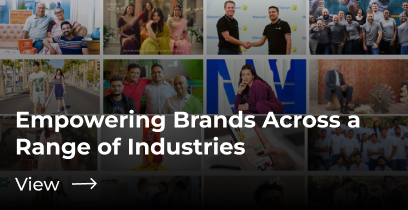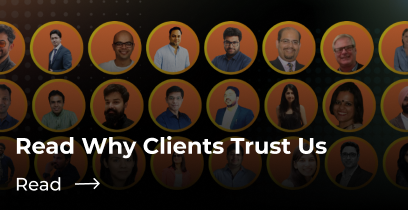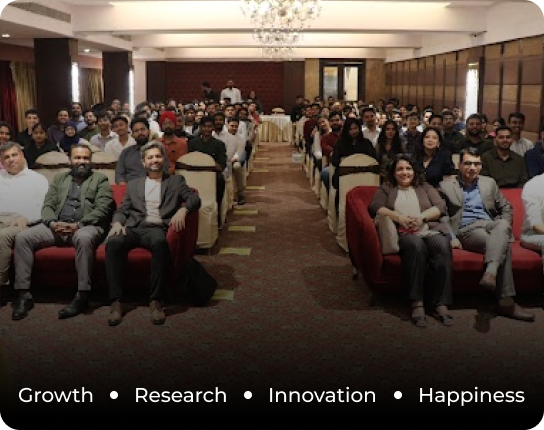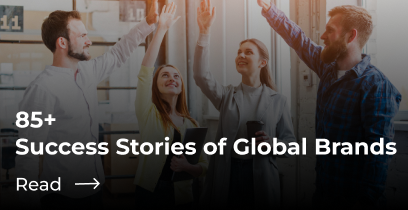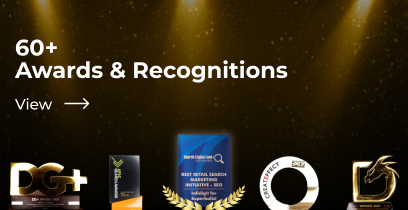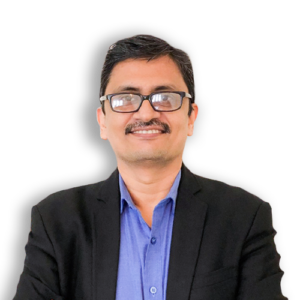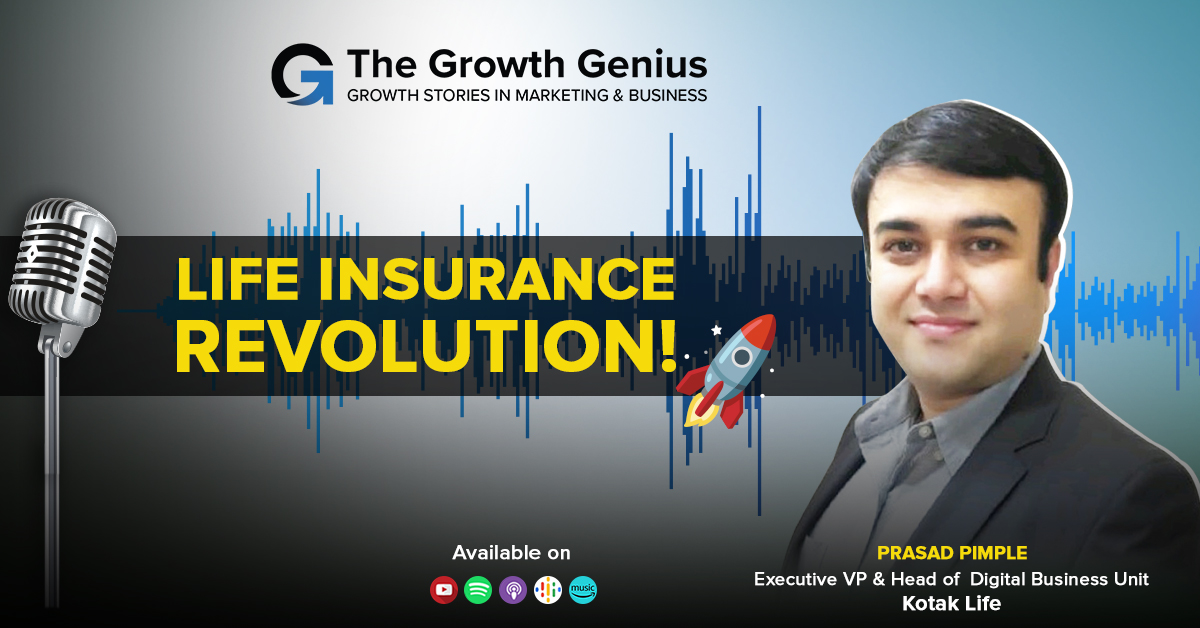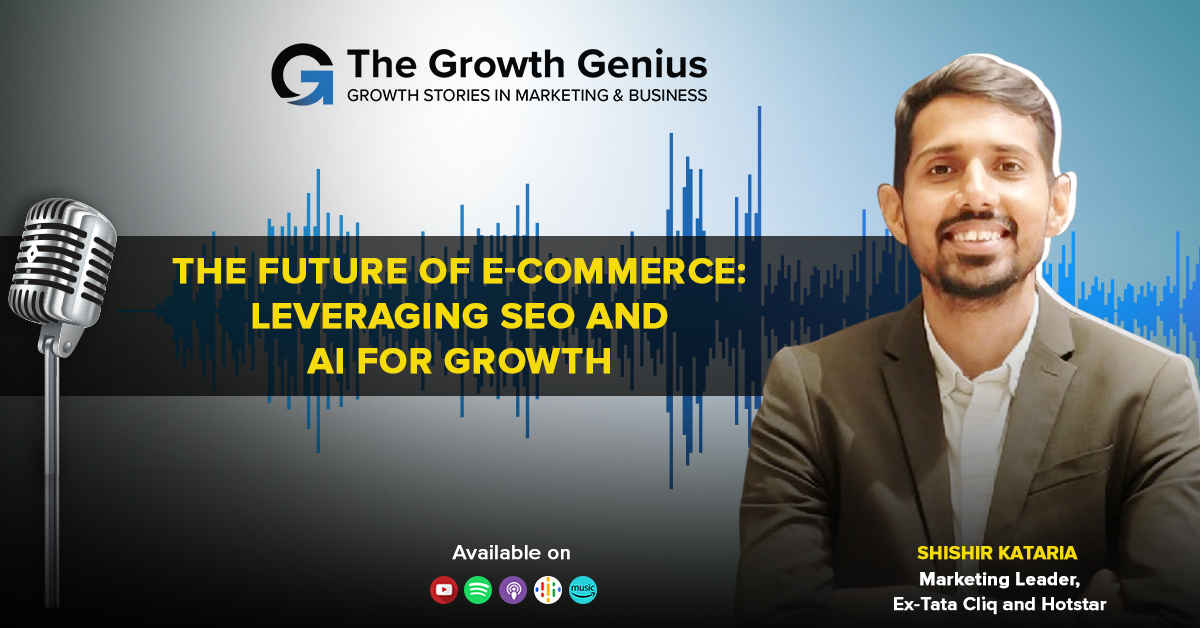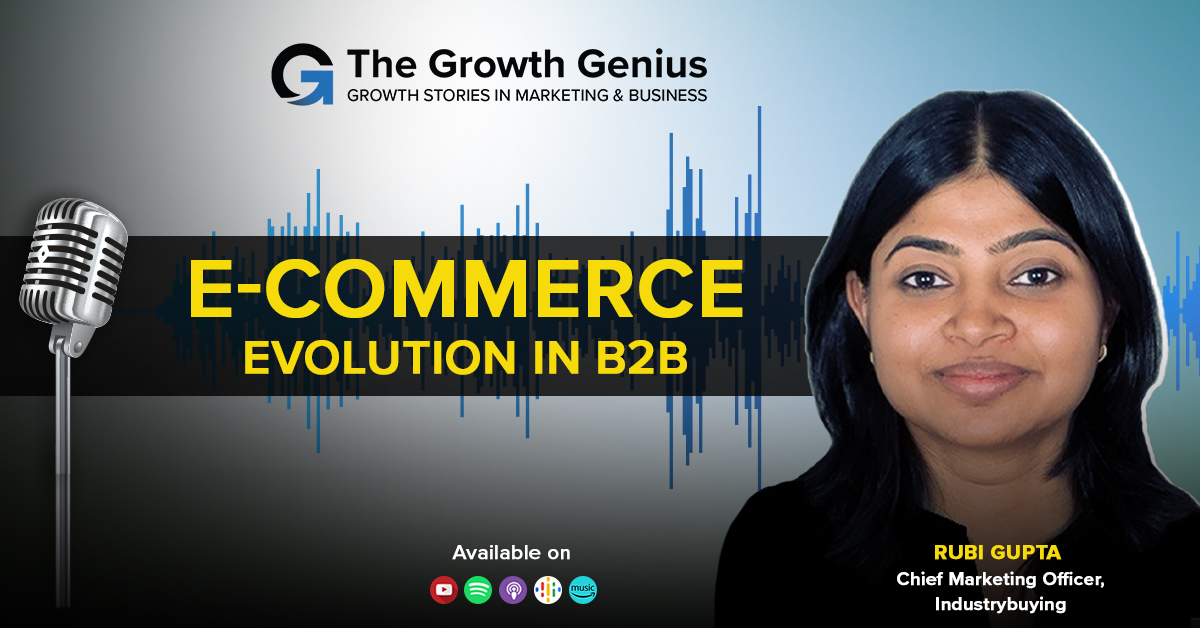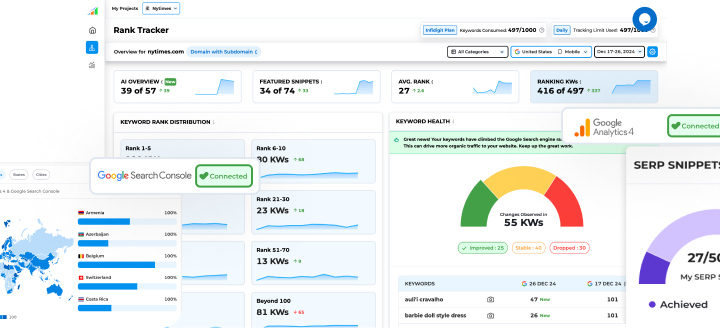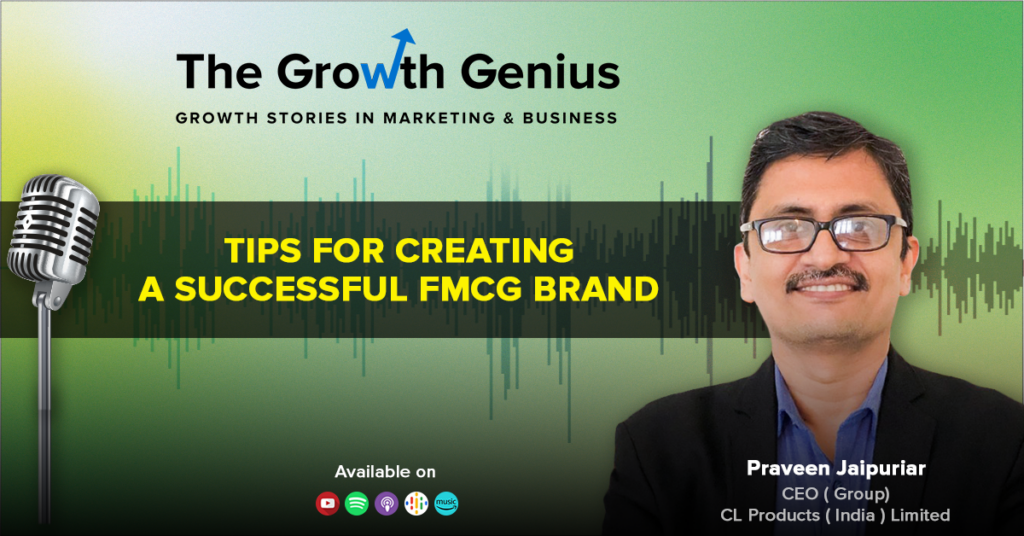Listen on your Podcast app
Summary
In this podcast episode, Praveen Jaipuria discusses consumer behavior and its impact on marketing strategies. He emphasizes the importance of understanding consumer psychology and how it influences purchasing decisions. Jaipuria highlights the need for marketers to adapt their strategies to meet the evolving needs and preferences of consumers. He also shares insights on the role of data analytics in gaining a deeper understanding of consumer behavior. By leveraging this knowledge, businesses can create targeted marketing campaigns that resonate with their target audience. Overall, this podcast provides valuable insights into consumer behavior and offers practical tips for marketers to effectively engage with their customers.
Key Take Aways
8 Key Takeaways for a Digital Marketer from the Blog “Consumer Behavior Marketing” by Praveen Jaipuria:
- Understanding Consumer Behavior: Digital marketers should focus on understanding consumer behavior to create effective marketing strategies.
- Importance of Data Analysis: Analyzing consumer data is crucial for identifying patterns and trends that can help in targeting the right audience.
- Personalization is Key: Customizing marketing messages and experiences based on consumer preferences can significantly improve engagement and conversion rates.
- Utilizing Social Media: Social media platforms provide a wealth of opportunities for digital marketers to connect with consumers and build brand loyalty.
- Mobile Optimization: With the increasing use of smartphones, digital marketers must ensure their websites and campaigns are mobile-friendly for a seamless user experience.
- Influencer Marketing: Collaborating with influencers who align with the brand’s values and target audience can help in reaching a wider consumer base.
- Importance of Reviews and Testimonials: Positive reviews and testimonials from satisfied customers can greatly influence consumer purchasing decisions.
- Continuous Learning: The digital marketing landscape is constantly evolving, so digital marketers must stay updated with the latest trends and techniques to stay ahead of the competition.
Read Transcript
Praveen Jaipuriar :- If you were to put a gun on my head and say that, what would you like to change? If you were to then I would say yes, that’s one thing I would say that I would have continued doing financing. I had to travel back.
Kaushal Thakkar:- No, but I would not put the gun in that case because I know what impact has been created on brands like Dabur, and Continental Coffee because of this decision.
Praveen:- Creating an FMCG brand is a very, very tough task. So much so that the research data tells us that out of every 100 launches, 99 are failures, it’s only one that succeeds. You know, one of my marketing mentors used to always tell us that… tell me that, you know, who is the consumer? The consumer is your wife and if it is so difficult to please your wife, you can understand how difficult it is to please the consumer. A very classic marketing strategy that we have followed is that okay… launch the product in the market, put in some advertisement on mass media and see if you can generate trials, where we said that probably that alone will not work.
Kaushal :- Welcome to The Growth Genius podcast brought to you by Infidigit. I’m Kaushal Thakkar, Founder of Infidigit and your host for the show today. We have a special guest with us. He’s a Marketing Strategist and leader who has built several brands. I’m sure that every person of Indian origin would have benefited from his contribution. If you have consumed products like Dabur Chyawanprash, Dabur Honey, Glucose, Hajmola, Pudin Hara, or Continental Coffee, Dabur Honey, Glucose, Hajmola, Pudin Hara, or Continental Coffee, you’re going to love this talk. Because we have the brain behind these products with us today. Please join me in welcoming Mr. Praveen Jaipuriar, who is the CEO of Continental Coffee. Hello, Mr. Praveen.
Praveen :- Hello, Kaushal.
Kaushal :- We are delighted to have you with us today. How are you doing?
Praveen :- I’m doing good. And thanks for inviting me here. It’s actually a matter of pleasure and honor to be amongst you and all of you. Thank you once again.
Kaushal :- Thanks, our pleasure as well. Praveen, while most of our listeners would have consumed the brands that you have built over the years, it would help if you could let us know more about yourself.
Praveen :- Okay, Kaushal, let me just give a little brief background about my personal upbringing and then my professional journey, very briefly. So I was born and brought up in a very small town, but a very organized set up like steel town township. That’s where I grew up. So what it did to me was a couple of things. One, it helped me understand the consumers better because it’s a township where you have lots of people from across India and a very cosmopolitan culture. So you kind of get to interact with a lot of people around and that actually helps you to understand people much better. And also, when you’re coming from a small town setup, what it does to you is that it helps you understand the value of money much better than what it would otherwise do. Because generally when you see small town children, they are generally more often than not hard pressed for money. We used to kind of even if you were to buy a chocolate, we used to kind of beg/borrow/steal with parents, and that helps you understand the value of money and sometimes it does help you when you grow up and when you are handling businesses or doing your own business, it really helps you to kind of imbibe that value that has come into you, helps you to drive the businesses in some way or the other. So that’s been my personal journey. And then I did my Graduation in Economics from Delhi University, and then did my MBA from K. J. Somaiya, Bombay. And thereafter I’ve been mostly into FMCG setups, into sales and marketing and later on business leadership roles. And I’ve kind of thoroughly enjoyed my last 20-25 years of journey. It’s been an arduous one, but when you look back onto it, it’s been a pleasurable one as well.
Kaushal :- Really well said Mr. Praveen. And I would connect with those words where you said that we’ll beg, borrow or steal. In our days at least the thing was that money was something which was not as easily possible like it is for our kids these days. And sometimes I still tell my son. I borrow the words from some of the other people from where I have heard. I tell him that your father is rich, my father was not this rich. And so I need to save on this. I’m not spending on this particular thing, but he feels more comfortable spending on it,
Praveen :- Right?
Kaushal :- I would connect well with those words. Mr. Praveen, while you mentioned your MBA and…let’s say if you were to time travel and you had to give advice to this Praveen who just graduated from BSchool 25 years ago, to do something differently, what would you advise him?
Praveen :- You know, that that generally is always a very tough question because, generally, you know, your immediate answer would be that you wouldn’t want to change anything that has happened. But there’s something when I reflect back, I’ll tell you a little story about my stint at [K. J.] Somaiya. When I came to Somaiya and did my Economics from Delhi University and I came here and I just wanted to pursue finance as a profession because I thought the background of economics helps you to understand finance as a function better. And that’s what I wanted to pursue. In fact, I did my summers with SSKI Finance, which is now Sharekhan. At that point of time, it was a very big project I did with them about setting up a primary channel in the IPO market. And that’s the time I don’t know whether you guys remember not. This was in ’96, the Indian finance market was going under a turmoil. There were issues, scandals, and it was post-Harshad Mehta era after ’91-’92. So it was a big turmoil and I was pretty scared about the whole thing. And I said that one year later, if I’m not getting a job, then my whole purpose of doing an MBA, again… I’ll connect to the roots of being a small town boy. The prime objective was to get a job as soon as possible. And with that mindset, I was really scared at that point of time. And I went to Professor Arya, who was the Director at Somaiya at that point of time, and he used to say, I don’t know at your time whether the new hostel was built, but our time, the old hostel was there. So each floor was dedicated to one section. So one floor was occupied by engineering, one by management, one by polytechnic. So on the top floor, Professor Arya and the warden used to stay. And I went to him late in the night and I told him, “Sir, I don’t think so I want to pursue finance anymore.” And he was pretty angry at me and he said, “What is this, Praveen? This is not done. And you’ve done such a good summer project, one of the best that has happened in the campus, and we are all looking up to you and you’re saying you don’t want to do it.” I said, “Sir, if I don’t get a job and I’m struggling to get a job one year down the line, what do I tell my parents who always wanted me to get a government job…” That point of time, ’90, this is ’96, when the whole private sector was just booming after liberalization. But still it wasn’t the in thing at that point of time, people still looked up to government jobs and more stable jobs. So I said, “if I don’t get one, I will have it. And after a lot of cajoling and all that, I said, no, I’m taking up marketing now. And I shifted to marketing. And while I don’t regret it, right now, I think that probably I shouldn’t have been so impatient to say that “I should change my stream and should have gone to do what I had originally planned to do.” But as luck would have it, and as destiny would have it, they sometimes say “it’s written here.” So probably it was written here. But if you were to put a gun on my head and say that, what would you like to change? If you were to then I would say yes, that’s one thing. I would say that I would have continued doing finance. I had to travel back.
Kaushal :- But I would not put the gun in that case because I know what impact has been created on brands like Dabur, Continental Coffee because of this decision. I’m not sure if you were in finance, would that benefit come to India because of that? I would not at least… And yes, for the audience, Mr. Praveen and I share…are from the same BSchool, K J Somaiya Institute of Management from Mumbai. He’s five years older than me. That’s where we stand. Praveen one other thing which I would love to learn from you is you’ve led several FMCG brands at Dabur, Balsara. The FMCG brands are the brands which are very iconic in their terms of operations, et cetera. What has been the learning related to growth from these industries?
Praveen :- So Kaushal, it’s been a very…I was in Balsara, then I joined Dabur. And in Dabur, I kind of…Dabur has got a plethora of brands and lots of categories, kind of handled a lot of them. And what I would like to say is that every category has, you know… From every category or every brand that I have handled, there has been immense learning potential and the learnings have been many. It’s very difficult to list so many of them. But one of the greatest things that I learned when I was handling brands is that, when you’re handling the brand, the most and most important thing which I have ever thought is that one should understand your consumers as best as possible. And sometimes we get caught up in our daily work so much and sometimes you get into this inertia of sitting in the office so much that you forget to meet your consumers. That’s one thing I tell most of the youngsters today, that, “if you were to make a mark in marketing or any sort of consumer centric business or activity, the most important thing is to understand consumers, meet them.” I was lucky enough to have mentors and bosses who were my bosses in the initial years, who used to push me to go to market as much as possible. And I’ll illustrate this by an example where you will be able to connect, why am I saying so? In 1996, when I was in Bombay, staying at the campus, at that point of time, Perfetti came to India and launched one of its brands… the most successful brand of it was Al-pen-li-be, and that was launched at that point of time. And the brand name was quite a tongue twister, Al-pen-li-be and the Bandra-Mahim…that hoarding which is a very big hoarding, very expensive one. There they had put a hoarding to make people pronounce Al-pen-li-be. Soal-penn-li-be was broken down into Al-Pen-Li-Be and that was for the Bombay audience because the company thought that people would find it very difficult. It’s an Italian company and you’ll find it very difficult to pronounce the name and that should not come in the way of marketing their product. So this happened in…in ’97 I passed out. I got campus recruited into Balsara and my first stint was in Bihar, south of Bihar. And after the first induction days of one month or so, I was supposed to travel in the rural markets. And I was traveling in one of these markets, which is in the coal mines of Jharkhand, which is near Dhanbad. And I was with my salesman and with my driver and we were in this auto and we were selling…you know… The whole idea was to produce sales into outlets. And we stopped by at a paan outlet, and there we were just… My salesman was trying to sell some products into that outlet. And that’s when I saw a young kid, a young rural kid with almost no shirt on the top with just a pair of pants. He was wearing pants and he came running, probably must be seven-eight years old, and he was holding a 50 paisa coin in his hand. And he came running and he told the guy, “ek Al-pen-li-be dena (give me one Al-pen-li-be).” Yeah? So when I heard that, I said, “look here, I don’t think this brand will ever have a problem.” Because if a rural kid is able to pronounce Alpenliebe, I think their fear of thinking that people may not be able to pronounce is not true, real. And it actually worked out like that. And the brand became a real big time success in Indian markets. And the other thing that I learned from…therefore… That triggered me to think that looking at your consumer, understanding your consumer, thinking what’s happening… And that told me a story that, “look here, there is a brand which has put up a crore rupee hoarding at Bandra…Mahim camp…that turnaround…big hoarding to educate Bombay, which is the most upmarket city of India. And here you come to rural India, and there is a kid who has come…and that told me a story that there is probably a unity in India, and an urban consumer and a rural consumer, probably apart from the fact, that affordability. But in terms of their ability to reach out, to communicate, their ability to understand their aspirations probably are not very different, they are manifested differently but probably we have a thread which joins all of us, and we are all the same. The fact of the matter is, I’m not going into the marketing theories, but what I’m trying to tell all of us is that a deep understanding of the consumer, observing your consumers, these are very, very critical things if one were to kind of succeed in consumer business.
Kaushal :- Thanks for sharing that. And I connect well with Alpenliebe. That was one candy which I used to relish even during my college days, even until the MBA days, at least. I remember having those Alpenliebe. So thanks at least for connecting us with history. And after Dabur, you transitioned to Continental Coffee. So how did Continental Coffee happen for you?
Praveen :- I was at Dabur and Continental Coffee actually… Just to give you a brief background about Continental Coffee, it is actually into coffee manufacturing. Continental Coffee manufactures coffee, and it’s a B2B player. It’s not a B2C player. So what it does is it manufactures coffees and gives its coffee to almost all players across the globe. It’s quite a large organization in terms of its capacity, probably the world’s third largest coffee manufacturer, and it’s pretty big in its own rights. And that’s the business model. So what they do is they make coffee and they supply coffee to all the coffee brand owners across the globe who want to sell coffee in their respective markets. So that was their business model till the last 20-25 years. And then they thought that why not enter into a B2C space also, so launch our own brands. And that’s when they got in touch with me. And for me also, what happened was, I was at Dabur doing well, and things were very settled in my own comfort zone and things were moving pretty nice. But then when this came through, I thought that this is a very different challenge. The difference is that, you are entering a setup or you’re trying to create a setup which is very new, completely different to the grain of the company, which is a B2B company or setting up a B2C setup for them and probably are doing it, and we are doing it from the scratch. So the whole, you know, probably joy and the pain of doing things or creating things from the scratch and to see that it succeeds over a period of time, I thought that’s a pretty good challenge and probably will add to my personal learning because what I’ve done is till now, I have worked on brands which are there and probably accelerated their growth or changed things around and done this. But these are all brands which are already there and you’re working for a large processed company. Then I thought, okay, let me come to a company where I create my own thing, create more processes and see if my creation, at least there are some green shoots out of these creations or not. So that was the reason I came to Continental [Coffee] from Dabur.
Kaushal :- Really nice that you joined there. In fact, for the audience, Continental Coffee was recently named as one of the Iconic Brands in 2022 by Economic Times. But Mr. Praveen, what we would love to learn from you is this particular journey of Continental Coffee to become an iconic brand.
Praveen :- So, yeah, it’s been a very tough journey, let me tell you. And the reason is because creating an FMCG brand is a very, very tough task. So much so that the research data tells us that out of every 100 launches, 99 are failures, it’s only one which succeeds. So that’s the low percentage of success, even for large companies, even for companies like Unilever, PNG, most of their new initiatives, they do not succeed. In Spite of the fact that they have so much resource, power with them. So that tells how difficult it is to crack consumers. It’s not easy to take a share of the consumer’s mind. One of my marketing mentors used to always tell us that…tell me that, “who is the consumer?” Consumer is your wife. And if it is so difficult to please your wife you can understand how difficult it is to please the consumer. That’s how it is. So therefore the success rate has been very, very low. And in fact when I was joining I had a discussion with the promoters that, you know, please don’t be under the impression that I’m coming from Dabur and Balsara. We have so much experience. Even with this kind of experience the chances of success is really 1% and we may after five years discover that we haven’t done as well as what we would have wanted to. But then again, coming here and there are two-three things that work. One is that because we had very strong One is that because we had very strong product knowledge. So Continental Coffee today as I was telling you is the world’s largest or one of the world’s largest coffee makers. And because we supply to so many people we have a plethora of blends with us. So that gives us a lot of R&D muscle power. So we could design or blend the product the way we wanted to and therefore that gave us a big edge. So we got the product right. And second thing is that when we started studying the market what we realized is it’s a very tough category to crack because as a consumer there is no impulsiveness about coffee because you don’t want to change your coffee brand. You don’t want to change your morning beverage ever, whether it is tea or coffee. So what you drink is what you drink, you don’t want to change it. So it was very difficult to penetrate the consumer. So we said okay, what…very classic marketing strategy that we have followed. okay, launch the product in the market, put in some advertisement on mass media and see if you can generate trials. We said that probably that alone would not work. So what we started doing is that we said that okay, we’ll do a massive amount of sampling of the product and we created a big team who would sample the product. When I say sampling, it was not dry sampling. So we didn’t used to give coffee sashes to people and say that go home and try this coffee. We used to set up centers where the coffee was made and we made people drink the coffee so that when they drink the coffee and if they like it, even if five out of 100 people like it, I probably will end up getting 5% share. So that was the whole strategy was very different although there is no rocket science here, it’s very simple. But most of the FMCG brands don’t go through these roads or even if they do sampling at a minimal level. At pre-COVID levels, we were doing 50,000 cups of sampling, every month. That’s the kind of scale we created and we said that only if people drink my coffee and if they like my coffee, their ability or their ability to try my coffee will become that much higher. So that’s how we started taking up step-by-step, step-by-step. And then after three-four years, we started seeing that yes, people are liking the coffee. There is a traction that is getting made and being generated. And that helped us to get into. So this coffee market is dominated only by two players. Nestle and Unilever almost share half of the market amongst themselves. So after three to four years to become the number three, although we are very small right now, very minute shares, but the very fact that we are now the number three brand in India is self-achievement, that one can say but yeah, step in the right direction. So that’s how things happen. And probably Economic Times kind of acknowledged this effort and ordered us as the Iconic Brand.
Kaushal :- Nice, really good. And you said 1 in 100, I would say one in 1000 or 10,000, because we are in India, which was at least five years back, a predominantly tea drinking country. And at that time having this particular vision speaks a lot about you, because that’s something and I love this particular strategy that does the sampling, setup stalls, let people taste it. That’s a wonderful way of establishing the brand. And it has really grown well.
Praveen :- That is again, coming back to the same thing that I said. If you are connected with the consumers, then it helps you to understand them. Because mostly classic marketing, where most of the marketers would have said, okay, let me put a lot of ads on TV and try. But we did not do it. And a lot of people ask us. So the first question when I tell people that we did sampling, they said that, “accha kaun-kaun se mall mein kar rahe ho?. “Which malls do you use?” And I used to tell them we never went to the mall at all for sampling because that’s not my consumer. So if you see the coffee construct in India, a lot of coffee is drunk, mostly drunk in South India. So the rest of the zones are tea drinking. South India is a coffee drinking zone. But here, where would you find people? We said we will not find them in the malls because those are very rarely up-market people and we want to sell them to the middle class. So where would you find them? So we used to put stalls right at the center of the marketplace. We used to set stalls in temples. In South India, going to a temple is a very common ritual that people follow religiously. So in the morning at 5 o’clock or 6 o’clock, our boys used to go to the temple, put on the coffee…We used to go to the temple authority and say that today we are going to treat coffee to all your devotees that are coming. So, they were very happy with this. We used to set up stalls and people used to prong the temple and then we used to make them bring coffee. It was a lovely, lovely way to connect. And that connection actually stayed with the consumers because they were drinking coffee at a very different place. They’re not drinking coffee where people are already soliciting them. Today when you go to the mall, there are ten people soliciting you. There is a credit card guy, there is a hair color guy, there is a perfume guy. So a lot of them are soliciting. But here is soliciting which happened at a very different level, at a very different connection. And these things, these are very small things but help you when you have understood your consumers well.
Kaushal :- These are the marketing learnings right, which we received from you, which makes me ask the next question which is about at least whatever I have read about you. I’ve understood that your take on Philip Kotler’s marketing theory is very different, especially in the context of India since it’s a very different market. Could you share your views or some examples around this? Why do you feel so?
Praveen :- I’ll just rephrase it. What I say generally is that the principles of What I say generally is that the principles of marketing laid out by Philip Kotler is the greatest. We all consider it as the bible, but sometimes what we do, the mistake that we do is we kind of take it into toto, the theory into practice. What we need to do is kind of customize it as per the market situation, as per the time, as per the kind of TGs (Target Groups) that you are going to target. So all that has to kind of come into play and probably therefore then you have to say that if that’s the theory, how can I not, let’s say reinvent but kind of rewrite in a sense which makes it relevant. So I’ll give you a very small example..not a small but in fact a pretty large example of a product that we launched in Dabur. And probably everybody was very skeptical whether this will succeed at all or not. So what I’m talking about is Red Toothpaste. So Red Toothpaste was launched back in 2002 or 2003. And that time the Indian market was dominated by mint toothpaste like Colgate, Pepsodent, and things like that and gels like Closeup and all. So a Red Toothpaste really didn’t make sense because it didn’t fit into category connotations, so as to say. And a lot of people at that point, most of the people said that this probably is going to succeed. Our idea was Red Toothpaste, because I don’t know whether you know or not or the audiences know or not. Dabur has a very strong powder brand called Lal Dant Manjan…It’s used in rural India, called Lal Dant Manjan…It’s used in rural India, by rural consumers when they are brushing. So India had this whole huge population who did not have brushes to brush the teeth. So they ended up using powder and used to use powder with their finger and brush. And Red Toothpaste… Red Tooth powder was very popular, especially in the Hindi heartland. And of course over a period of time people were shifting to paste and the powder sales were going down and thought this would make a logical sense to have a Red Toothpaste. So while that was launched in a category which was a white category and had no connotation, I don’t know whether any one of you have tasted it, some of you would have, you would realize it’s a very different toothpaste. It’s actually completely challenging the toothpaste norms, the category norms. It’s not minty, it’s not sweet, it’s very strong. Most other people find it very harsh. And then we said that, “makes sense because there is a strong insight that is lying with people,” that all Indians, we face some sort of tooth problems and we end up blaming ourselves that we don’t brush it. So if a child gets a cavity, we all scold the child that you don’t brush properly, you eat too much of chocolates and all that. But we kind of don’t question the products that we use. So we said, “we must challenge that.” We said that, “if everybody has a problem, which means that your toothpaste is a problem, which means that your toothpaste is not working, so get a working toothpaste.” And the brand has done extremely well for Dabur over the last so many years and it has created a very different category, very different category norms, very different category of this thing. A lot of people came to us and said that I won’t ever brush with this toothpaste because when I spit out, my whole wash basin is a little reddish in color. But we kind of said no, I don’t think so. Product will be a problem as long as I’ll be able to satisfy the needs of the consumer. If the need is higher than the problems that this product is creating, I think we will succeed. And they stayed with that, probably. I wouldn’t say that it’s the antithesis of [Philip] Kotler, but yes, it tells you that breaking norms can sometimes be very successful. And second, a little tongue in cheek example that I’ll give you and I have read this somewhere and that’s why I say that sometimes Kotler theories could be overturned is this whole case about case study about Nokia. Most of the people have talked about this and said that this is one of the most, or used to be one of the most successful brands. Year after year when the brand survey was done, it was always beyond the top, as the top most trusted brand of India, Nokia. And one fine day it just suddenly vanished. And people said that they could not keep up with product innovation. So there were other phone brands which came and which were innovative. And then Micromax came, and then these new age Vivo, Oppos of the world came, and they were far more, far better in terms of product innovation. And Nokia could not keep up to it, and because they were not up to the times, they were flawed. But the theory that I am putting forward is a completely different one. So the theory is more psychological in nature. The reason why Nokia flopped is because of its ringtone. So this whole time of 1999-2000 was a time when So this whole time of 1999-2000 was a time when India, as a corporate culture was booming, we were getting away from this whole 9-5 job phenomena because we had seen our fathers working, going to office at probably 9 o’clock and coming back at 5 or 6 o’clock in the evening. And that was the thing. But the whole thing was changing a lot. We were becoming 24×7 managers, and the phone was actually accelerating this whole concept in a very accelerated manner. So what was happening was that we had started having phones. First of all, you were available at any point of time, so anybody and everybody could call you. Then the mail started happening on the phone, the messages started happening on the phone, and your whole work started on the phone. So whenever a Nokia ring or ring happened, it created a massive anxiety in your head and you really started hating those ringtones. And that’s one of the theories that I would propose, and I would urge all my listeners and viewers to read this book called Biology by Martin Lindstrom, and he puts a lot of these interesting theories, and to add and he puts a lot of these interesting theories, and to add one more thing to this is the whole cigarette thing. So he has done a research on a lot of cigarette smokers and says that, “the warning on the pack actually doesn’t stop you from smoking, but also increases your actually doesn’t stop you from smoking, but also increases your anxiety and therefore you start smoking more.” It actually does the opposite. So these are some of the theories if you put forward, really, it’s not in the books and it’s completely opposite to the case studies, the theories, the marketing principles that have been put forth, but it can make you stop and think that, “was that the reason?” So read this book. If you lay hands on. It’s a very interesting book, and you all will love it.
Kaushal :- Thank you, Mr. Praveen for sharing that, especially the example of Dabur. In fact, I’m thankful to the Dabur brand, my parents, who got me into that habit of using the Dabur Lal Dant Manjan in my early days, and then to my wife who got the Dabur Red Toothpaste to our home when she stepped into the home. In fact, last month only, I was visiting a dentist and she told me that, “hey Kaushal, how are you maintaining your tooth so well? No cavities. This is a kind of exception. It’s not good for our business.” That really helps. Thanks a lot for whatever work has gone behind building that brand. It’s helping many more people than you would have ever imagined. So thank you for that. Praveen, the last question which I have is more about the core habits, principles or the factors that have made Praveen Jaipuriar a genius that the world looks up to today. What are those…what is that secret sauce?
Praveen :- First of all, I’m not a Genius. Second, I don’t know how many people look up to…up to me or not. But there is one piece of advice which I give which I tried imbibing and I can relate because when I was a youngster, I used to feel the same is the whole thing about generally when you are young you’re very anxious to do things very quickly or you’re anxious to make things happen very quickly. So I have always seen that patience is one virtue, patience and perseverance, which helps all of us a lot and it’s not only about individuals but it is about business, it’s about brands. You would see that when we see brands, when we see businesses and successful ones we generally see the endpoints. We see that okay, this brand has become successful or this individual has become successful or this business has become successful. What we don’t see is the years and years of hard work and perseverance that goes behind it. Therefore the same is true for individuals as well. Whenever you are looking at your career I tell people that career and money are very, very similar. Just as you say, money has a compounding effect. They say in finance you put your money into a mutual fund and it doesn’t overnight start giving you return. What happens is that over a period of time you start seeing the returns and then it starts compounding. Similar is the case with career. Generally, we get anxious, we are into two, three years of job and we want to kind of change, or we want to do something better or newer or which gives us more salary and things like that. But trust me, that’s not a very good strategy. Because what happens is that you end up not learning and you end up not compounding your career. As a leader, when I see CVs where people have spent a lot of time at a certain place, it gives me a lot of confidence that the person has learned a lot and will be able to contribute more. That’s one thing. And I got this advice when I started my career, six-seven months into my career, I was like thinking what am I doing? Just to continue my conversation, where from one of the earlier questions I was telling you that I used to travel in an auto to sell products from shop to shop and I found it very, in a sense, a little demeaning because I’ve done my MBA and most of my friends were sitting in good AC offices. And then I happened to know and through one of my relatives, a very senior consultant. And I went to him and I said that, look here, I want to change jobs. I don’t think so. I should be supposed to be doing this. So he said, I can get you a job. I am a consultant. I’m in this field of head hunting. So I can get you one different job. But would you like to hear any advice from me? So I said, yeah, of course, please tell me. So he said that, take my advice, don’t ever think of doing any changes or think of changing your job. Three years, keep doing this, keep traveling in the auto, keep selling the product. Three years, keep doing it and then you will never, ever come back to me with a request for a job change. Things will automatically start happening to you. And till then, whenever I meet him, I’m really thankful to him. I tell him that I really got your advice at the right time. And so much thanks to you that you told me not to change. Otherwise I wouldn’t have been what I am today. So I keep telling people the same thing, that perseverance and patience have these two qualities. I think all things will work out for you.
Kaushal :- Wonderful! That’s a good statement for the youth today. Thank you Praveen for joining us on this show. Definitely, I’m going to read that book, Buyology and Life sciences by Martin Lindstrom and at least I’ll share the learnings with you as well later on, sometimes on a chat. But it was a pleasure having you on this show.
Praveen :- Thank you so much Kaushal, for having me. It was wonderful interacting with you.
Kaushal :- Thank you so much for joining us on this episode of The Growth Genius.
I hope you learned some great marketing and growth lessons from Mr. Praveen Jaipuriar today. If you did, please share the key takeaways in the comment section below on YouTube. Now go out there and create Growth for yourselves and your organization. See you next week!

Popular Searches
How useful was this post?
0 / 5. 0



